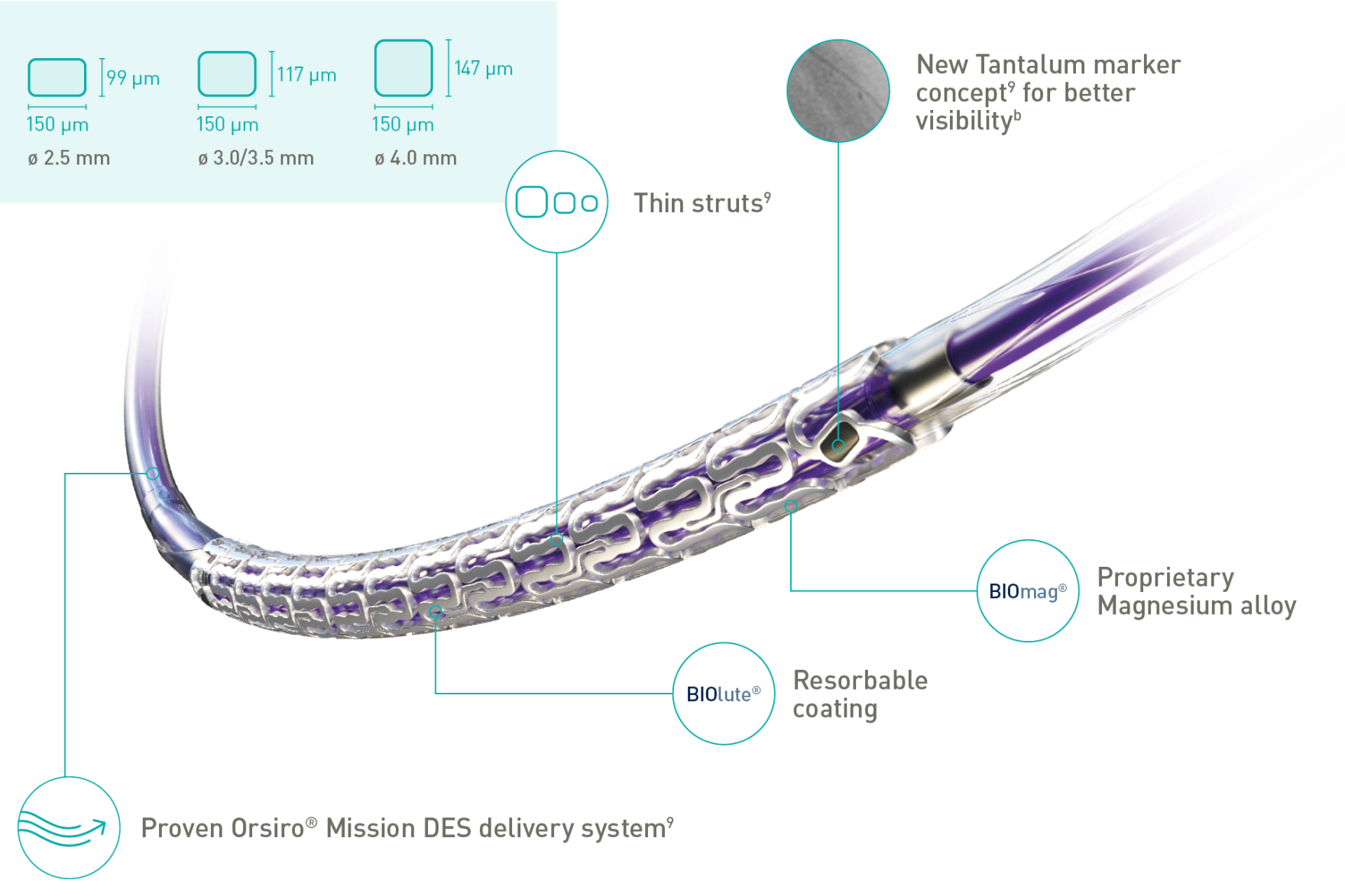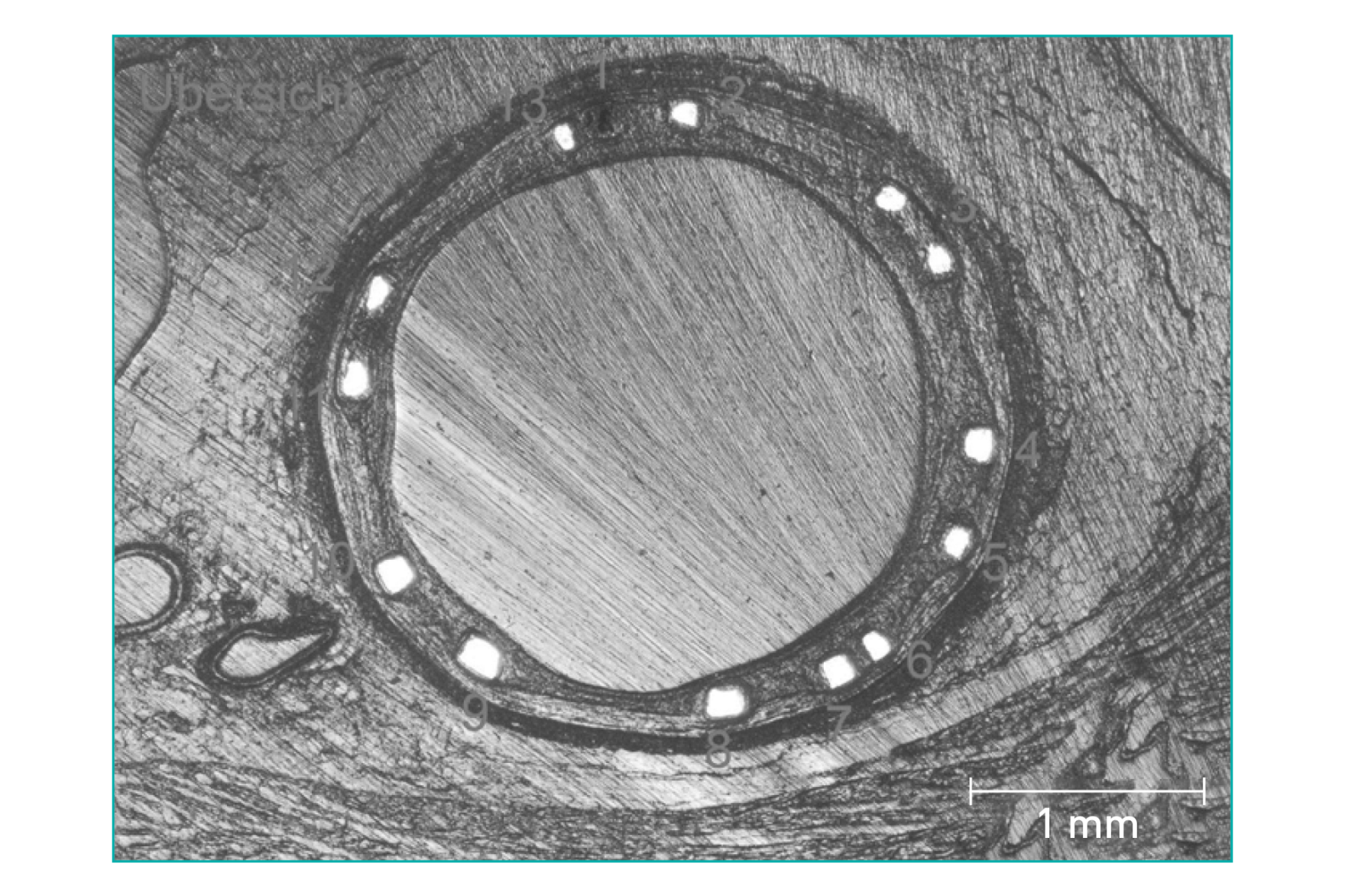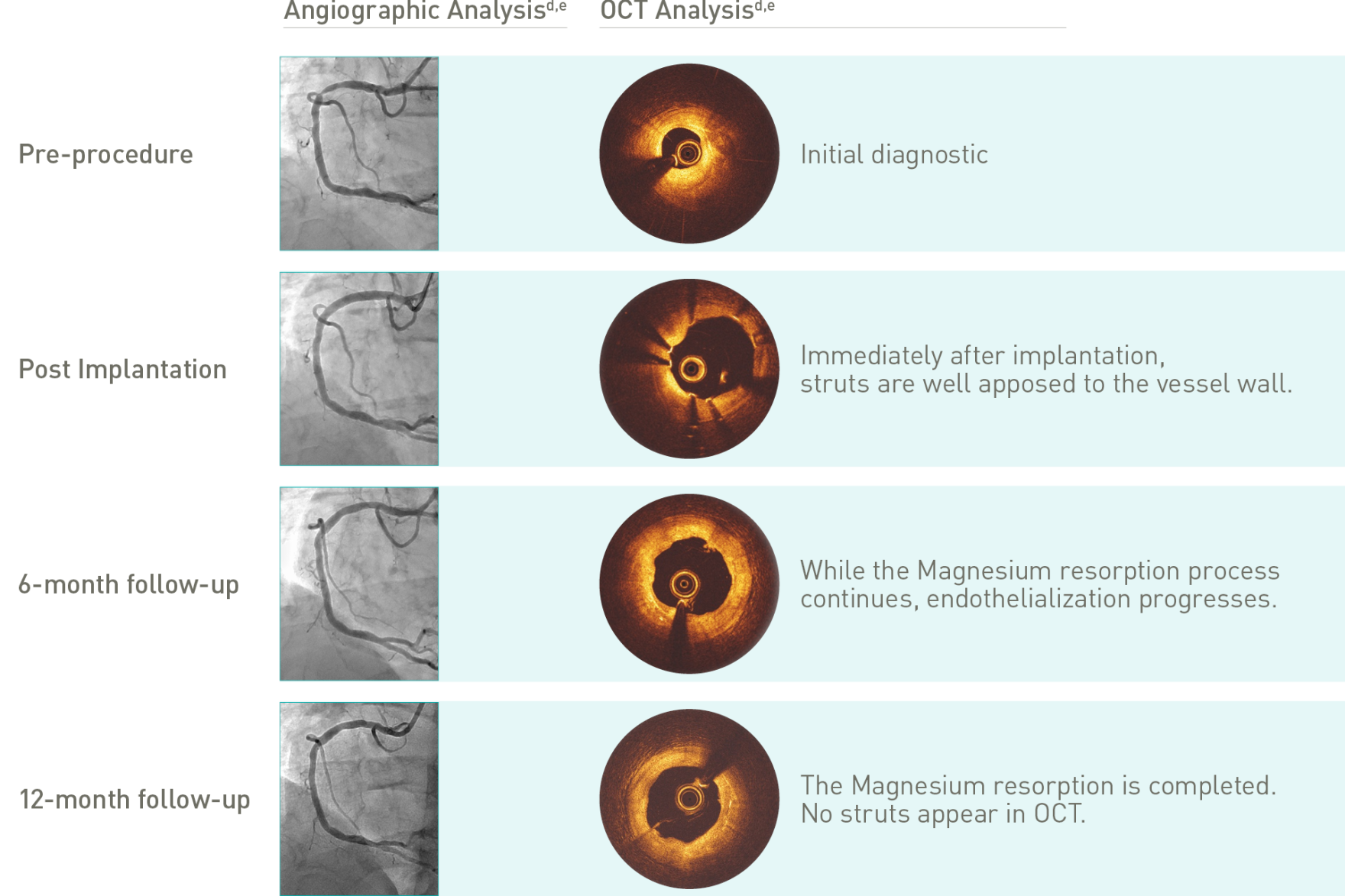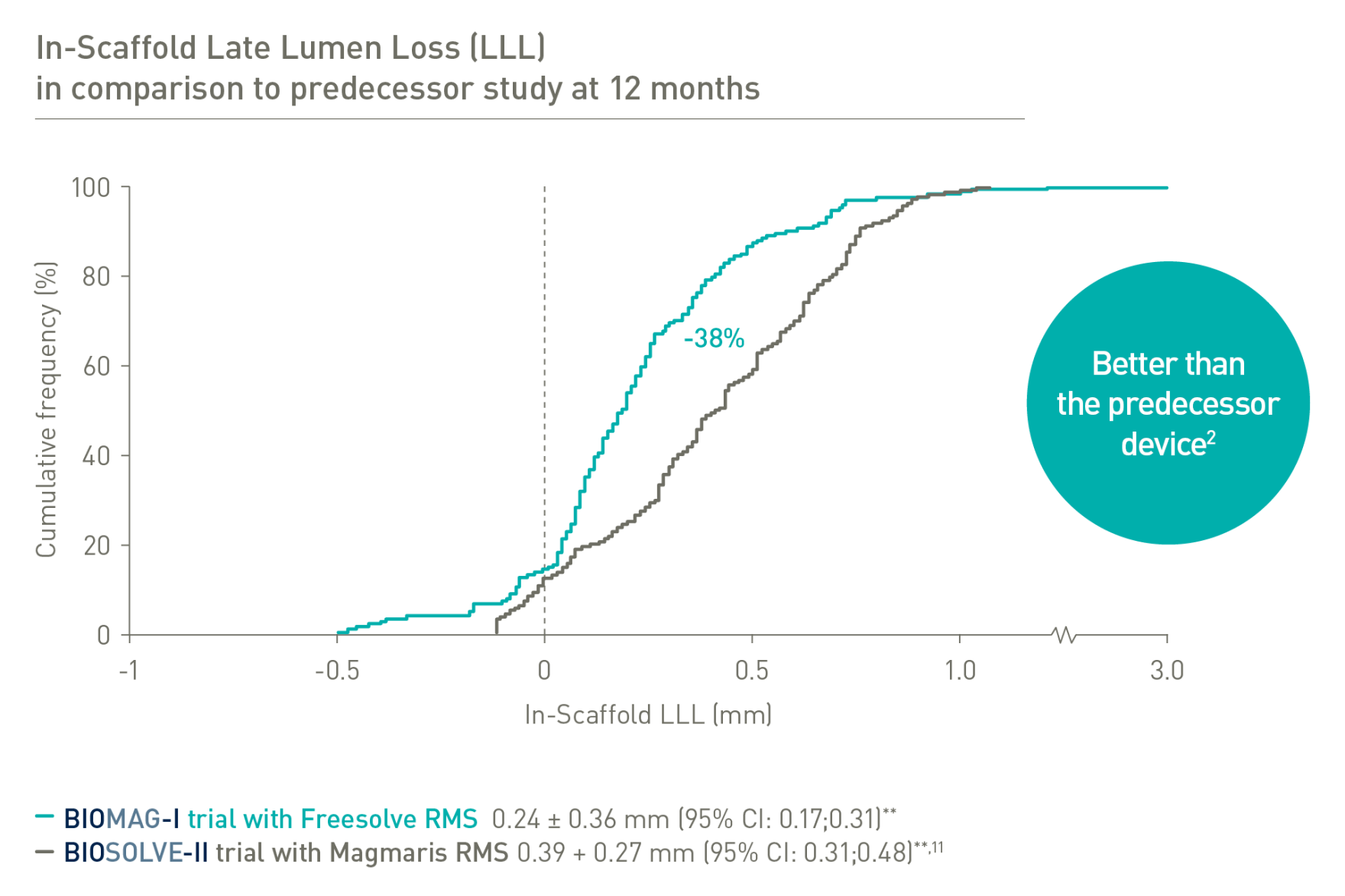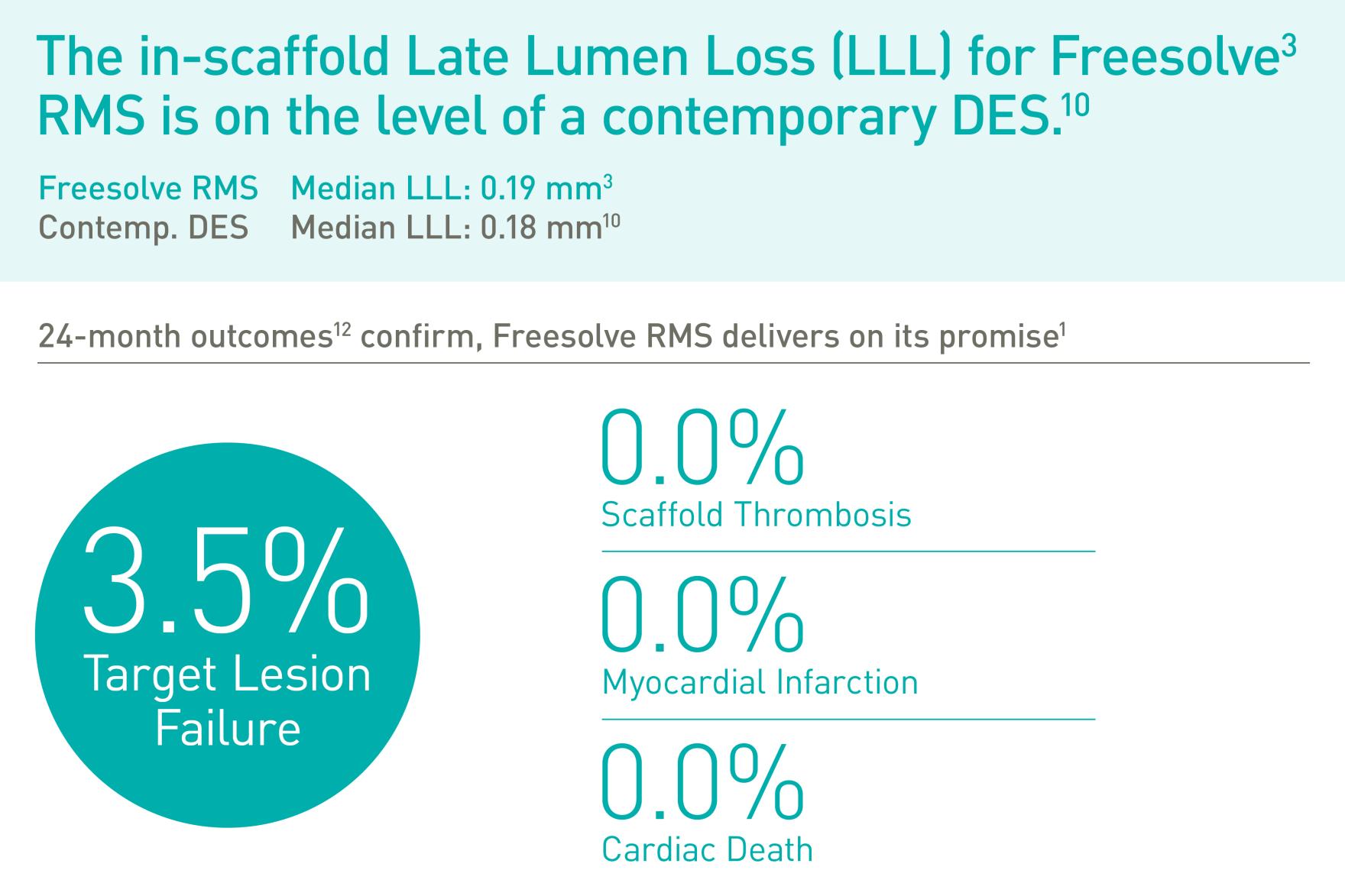Freesolveᵀᴹ
Aanbevolen voor de novo kransslagaderletselsa
Support
Resorbable coronary scaffolds verbreden vernauwde kransslagaders en bieden tijdelijke ondersteuning aan het bloedvat. Hierdoor kunnen de scaffolds een ononderbroken bloedstroom in de kransslagaders mogelijk maken, met lage percentages van stent trombose (ST) en target lesion revascularization (TLR).
Resorb
Door te degraderen na het vervullen van hun ondersteunende functie, bieden ze alle mogelijkheden voor toekomstige therapieën.
Product Highlights
Presteert als DES5
Optimale vaatondersteuning6,7
Magnesium volledig geresorbeerd na 12 maanden8
Uitstekende veiligheid en werkzaamheid2,3
Predictable, homogenous resorption process⁶
Equal resorption between struts6
Uniform shape due to homogenous strut resorption6
More than 3 months vessel support6,7
>99% of struts no longer visible at 12 months8
BIOMAG-I First-In-Human (FIH) trial3
Product Overview
Freesolveᵀᴹ

Nieuw Tantalum-markerconcept voor betere zichtbaarheid
Dunne struts
BIOlute® Resorbable coating
BIOmag® Proprietary Magnesium alloy
Technische kenmerken
| Scaffold | |||||
|---|---|---|---|---|---|
| Scaffold material | Proprietary BIOmag® Magnesium alloy | ||||
| Strut thickness | ø 2.5 mm: 99 μm; ø 3.0/3.5 mm: 117 μm; ø 4.0 mm: 147 μm |
||||
| Maximum expandable diameter | Nominal diameter + 0.6 mm | ||||
| Markers | One oval Tantalum marker at each end | ||||
| Drug coating | BIOlute® resorbable Poly-L-Lactide (PLLA) eluting a limus drug |
||||
| Delivery system | |||||
| Catheter type | Rapid exchange | ||||
| Catheter length | 140 cm | ||||
| Recommended guide catheter | 6F | ||||
| Crossing profile | ø 2.5 mm ≤ 1.3 mm; ø 3.0-4.0 mm ≤ 1.4 mm | ||||
| Guide wire diameter | 0.014” | ||||
| Nominal pressure (NP) | 10 atm | ||||
| Rate burst pressure (RBP) | 16 atm | ||||
Vessel Sizing
| Scaffold ø (mm) (SD) |
Recommended ø (mm) (RVD) |
|---|---|
| 2.50 | 2.50 - 2.70 |
| 3.00 | 2.70 - 3.20 |
| 3.50 | 3.20 - 3.70 |
| 4.00 | 3.70 - 4.20 |
Compliance Tabel
| Balloon diameter (mm) | ||||
|---|---|---|---|---|
| ø 2.50 | ø 3.00 | ø 3.50 | ||
| Nominal Pressure (NP) |
atm** ø (mm) |
10 2.52 |
10 3.04 |
10 3.54 |
| Rated Burst Pressure (RBP) |
atm** ø (mm) |
16 2.72 |
16 3.29 |
16 3.79 |
| *1 atm = 1.013 bar | ||||
Bestel Informatie
| Scaffold ø (mm) |
Scaffold length (mm) |
||||
|---|---|---|---|---|---|
| 13 | 18 | 22 | 26 | 30 | |
| 2.50 | 443103 | 443104 | 443105 | - | - |
| 3.00 | 443108 | 443109 | 443110 | 482156 | 443111 |
| 3.50 | 443113 | 443114 | 443115 | 482157 | 443116 |
| 4.00 | 443118 | 443119 | 443120 | 482158 | 443121 |
Downloads en Links
Downloads
Media
KOL Interviews
How can we help you?
References
Target Lesion Failure (TLF) is a composite of Target-Vessel Myocardial Infarction (TV-MI), clinically-driven Target Lesion Revascularization (CD-TLR) and Cardiac Death. *99.3% resorbed at 12 months (markers are not resorbable), based on clinical data; **based on QCA paired data. a. Indications as per IFU; b. BIOMAG-I case in normal cine projection, courtesy of Prof. Michael Haude, Rheinland Klinikum Neuss GmbH, Lukaskrankenhaus, Neuss, Germany; c. Xience Sierra DES (Abbott); d. Angiographic and OCT Analyses derived from two different BIOMAG-I cases, courtesy of Prof. Michael Haude, Rheinland Klinikum Neuss GmbH, Lukaskrankenhaus, Neuss, Germany; e. The 4P protocol was respected.
1. IIB Benchtest data, BIOTRONIK data on file; 2. Haude M. et al., the Lancet eClinicalMedicine 2023;59: 101940; 3. Haude, M. et al., EuroIntervention 2023;19:1-1 published online May 2023; 4. Seguchi M et al. OCT-Analysis 12M, presented at ESC 2023; 5. BIOTRONIK data on file, IIB Benchtest data: Freesolve in comparison to BIOTRONIK Orsiro Mission and Abbott Xience Sierra; 6. Based on pre-clinical data, Seguchi, M. et al., EuroIntervention 2023;18-online publish-ahead-of-print January 2023; 7. BIOTRONIK data on file, in comparison to predecessor device; 8. Based on intravascular OCT analysis of the BIOMAG-I trial presented by Dr. M. Seguchi at ESC 2023; 9. BIOTRONIK data on file; 10. Byrne, RA. et al., Eur Heart J 2015;36:2608-2620; 11. Haude M., et al. Sustained safety and performance of the second-generation drug-eluting absorbable metal scaffold in patients with de novo coronary lesions: 12-month clinical results and angiographic findings of the BIOSOLVE-II first-in-man trial. Eur Heart J. 2016;37:2701-9. 12. BIOMAG-I: two-year clinical outcomes of the resorbable magnesium Scaffold-DREAMS 3G, Moderated e-Poster presented by Prof. M. Haude at EuroPCR 2024.
BIOSOLVE-II and BIOMAG-I based on Kaplan-Meier failure estimate analysis.
BIOlute, BIOmag, BIOMAG, BIOSOLVE, Orsiro, Orsiro Mission, Magmaris & Freesolve are trademarks or registered trademarks of the BIOTRONIK Group of Companies. All other trademarks are the property of their respective owner.


